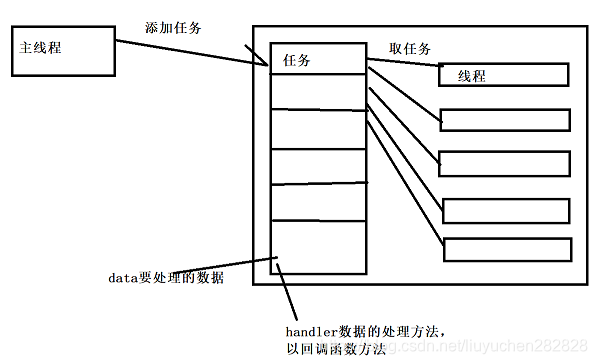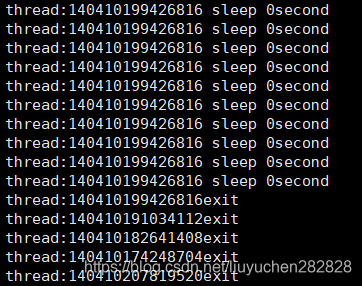线程池
概念:
一堆线程+任务队列
作用
- 避免大量线程频繁的创建/销毁时间成本
- 避免瞬间大量线程创建耗尽资源,程序崩溃危险
实现
创建固定数量的线程+创建一个线程安全的任务队列

一种线程使用模式。
- 线程过多会带来调度开销,进而影响缓存局部性和整体性能。
- 而线程池维护着多个 线程,等待着监督管理者分配可并发执行的任务。这避免了在处理短时间任务时创建与销毁线程的代价。
- 线程池不 仅能够保证内核的充分利用,还能防止过分调度。可用线程数量应该取决于可用的并发处理器、处理器内核、内 存、网络sockets等的数量
线程池应用场景
- 需要大量的线程来完成任务,且完成任务的时间比较短。 WEB服务器完成网页请求这样的任务,使用线程池技术是非常合适的。因为单个任务小,而任务数量巨大,你可以想象一个热门网站的点击次数。 但对于长时间的任务,比如一个Telnet连接请求,线程池的优点就不明显了。因为Telnet会话时间比线程的创建时间大 多了。
- 对性能要求苛刻的应用,比如要求服务器迅速响应客户请求。
- **接受突发性的大量请求,但不至于使服务器因此产生大量线程的应用。**突发性大量客户请求,在没 有线程池情况下,将产生大量线程,虽然理论上大部分操作系统线程数目最大值不是问题,短时间内产生大量线程 可能使内存到达极限,出现错误
线程池的分类
- FixThreadPool------固定线程池
- CachedThreadPool-----缓存线程池
- ScheduledThreadPool—调度线程池
- SingleThreadPool-----单任务线程池
特点介绍
FixedThreadPool
- 通过Exector的newFixedThreadPool静态方法来创建
- 线程数量固定的线程池
- 只有核心线程切并且不会被回收
- 当所有线程都处于活动状态时,新任务都会处于等待状态,直到有线程空闲出来
CachedThreadPool
- 通过Exector的newCachedThreadPool静态静态方法来创建
- 线程数量不定的线程池
- 只有非核心线程,最大线程数量为Integer.MAX_VALUE,可视为任意大
- 有超时机制,时长为60s,即超过60s的空闲线程就会被回收
- 当线程池中的线程都处于活动状态时,线程池会创建新的线程来处理新任务,否则就会利用空闲的线程来处理新任务。因此任何任务都会被立即执行
- 该线程池比较适合执行大量耗时较少的任务
ScheduledThreadPool
- 通过Exector的newScheduledThreadPool静态方法来创建
- 核心线程数量是固定的,而非核心线程数不固定的,并且非核心线程有超时机制,只要处于闲置状态就会被立即回收
- 该线程池主要用于执行定时任务和具有固定周期的重复任务
SingleThreadPool
- 通过Exector的newSingleThreadPool静态方法来创建
- 只有一个核心线程,它确保所有的任务都在同一个线程中按顺序执行。因此在这些任务之间不需要处理线程同步的问题
线程池实现

#include <iostream>
#include <queue>
#include <stdlib.h>
#include <unistd.h>
#include <time.h>
#include <pthread.h>
typedef bool (*task_callback)(int data);
class Task
{
public:
Task(){
}
Task(int data, task_callback handler){
_data = data;
_handler = handler;
}
~Task(){
}
public:
//设置任务处理的数据以及处理方法
void SetTask(int data, task_callback handler){
_data = data;
_handler = handler;
}
//执行任务
bool Run() {
return _handler(_data);
}
private:
int _data;
task_callback _handler;
};
#define MAX_THR 5
#define MAX_QUE 10
class ThreadPool
{
public:
ThreadPool(int qmax = MAX_QUE, int tmax = MAX_THR):
_thr_max(tmax), _capacity(qmax), _thr_cur(tmax){
pthread_mutex_init(&_mutex, NULL);
pthread_cond_init(&_cond_con, NULL);
pthread_cond_init(&_cond_pro, NULL);
}
~ThreadPool(){
pthread_mutex_destroy(&_mutex);
pthread_cond_destroy(&_cond_con);
pthread_cond_destroy(&_cond_pro);
}
public:
static void *thr_start(void *arg) {
ThreadPool *pool = (ThreadPool*)arg;
while(1) {
pool->QueueLock();
while(pool->QueueIsEmpty()){
pool->ConWait();
}
Task tt;
pool->QueuePop(&tt);
pool->ProWakeUp();
pool->QueueUnLock();
//为了防止处理时间过长导致其它线程无法获取锁
//因此解锁之后才进行处理
tt.Run();
}
return NULL;
}
bool ThreadPoolInit() {
pthread_t tid;
int ret, i;
for (i = 0; i < _thr_max; i++) {
ret = pthread_create(&tid, NULL, thr_start,(void*)this);
if (ret != 0) {
std::cout<<"thread create error\n";
return false;
}
pthread_detach(tid);
}
return true;
}
void AddTask(Task tt) {
//向线程池添加任务
QueueLock();
while(QueueIsFull()) {
ProWait();
}
QueuePush(tt);
ConWakeUp();
QueueUnLock();
}
void ThreadPoolQuit(){
//退出线程池中所有的线程
_quit_flag = true;
while(_thr_cur > 0) {
ConWakeUpAll();
usleep(1000);
}
return;
}
private:
void QueuePush(Task tt){
_queue.push(tt);
}
void QueuePop(Task *tt){
*tt = _queue.front();
_queue.pop();
}
void QueueLock(){
pthread_mutex_lock(&_mutex);
}
void QueueUnLock(){
pthread_mutex_unlock(&_mutex);
}
void ProWait(){
pthread_cond_wait(&_cond_pro, &_mutex);
}
void ProWakeUp(){
pthread_cond_signal(&_cond_pro);
}
void ConWait(){
//进入这个函表示现在没有任务
if (_quit_flag == true) {
//若线程池要求退出
_thr_cur--;
std::cout<<"thread:"<<pthread_self()<<"exit\n";
pthread_mutex_unlock(&_mutex);
pthread_exit(NULL);
}
pthread_cond_wait(&_cond_con, &_mutex);
}
void ConWakeUp(){
pthread_cond_signal(&_cond_con);
}
void ConWakeUpAll(){
pthread_cond_broadcast(&_cond_con);
}
bool QueueIsFull(){
return (_queue.size() == _capacity);
}
bool QueueIsEmpty(){
return _queue.empty();
}
private:
int _thr_max;
int _thr_cur;
int _quit_flag;
std::queue<Task> _queue;
int _capacity;
pthread_mutex_t _mutex;
pthread_cond_t _cond_pro;
pthread_cond_t _cond_con;
};
bool task_handler(int data){
//休眠一段时间
srand(time(NULL));
int sec = rand()%5;
std::cout<<"thread:"<<pthread_self()<<" sleep "<<sec<<"second\n";
sleep(sec);
return true;
}
int main()
{
ThreadPool pool;
Task tt[10];
pool.ThreadPoolInit();
int i;
for (i = 0; i < 10; i++) {
tt[i].SetTask(i, task_handler);
pool.AddTask(tt[i]);
}
pool.ThreadPoolQuit();
return 0;
}











 本文深入探讨线程池的概念,其如何避免线程频繁创建与销毁带来的性能损失,以及在处理大量短期任务时的优势。文章详细介绍了四种线程池类型:固定线程池、缓存线程池、调度线程池和单任务线程池的特点及适用场景,并提供了C++实现示例。
本文深入探讨线程池的概念,其如何避免线程频繁创建与销毁带来的性能损失,以及在处理大量短期任务时的优势。文章详细介绍了四种线程池类型:固定线程池、缓存线程池、调度线程池和单任务线程池的特点及适用场景,并提供了C++实现示例。
















 3万+
3万+

 被折叠的 条评论
为什么被折叠?
被折叠的 条评论
为什么被折叠?








